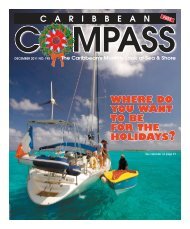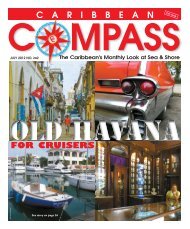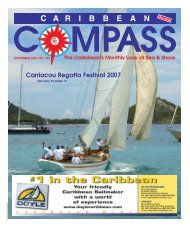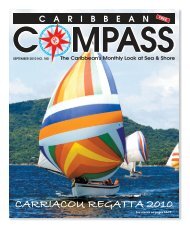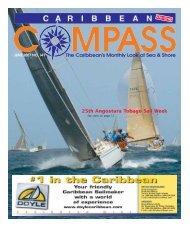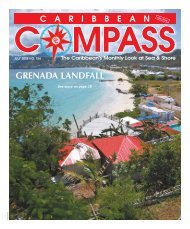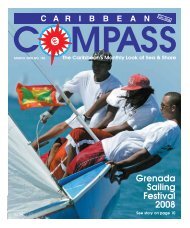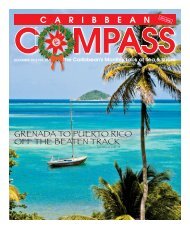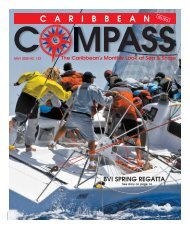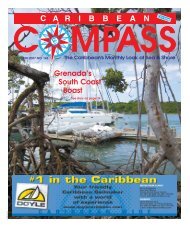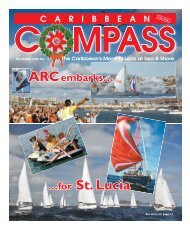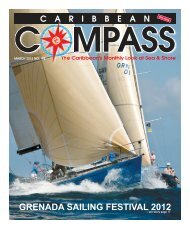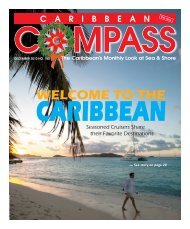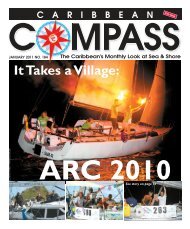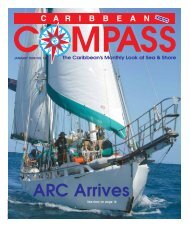Create successful ePaper yourself
Turn your PDF publications into a flip-book with our unique Google optimized e-Paper software.
MAY <strong>2009</strong> CARIBBEAN COMPASS PAGE 42<br />
FOR SALE<br />
GLASS BOTTOM BOAT<br />
Hull: Fiberglass, Built in France 1986<br />
Length: 46.6 ft, width: 16 ft, 2.5 Tons<br />
2x50 HP Diesel Volvo Penta<br />
Capacity: 24 Passengers + 2 crew<br />
Price: 45 000 USD<br />
ALUMINUM CATAMARAN 1986<br />
length: 12 meters, width 6,60 meters<br />
Depth: 1 meter<br />
Main Sail area 50m2 - Foresail 20m2<br />
Diesel Yanmar 3 GM 30x2<br />
Capacity: 26 passengers.<br />
Price: 50 000 USD<br />
WALLILABOU<br />
ANCHORAGE<br />
WALLILABOU BAY HOTEL<br />
VHF Ch 16 & 68<br />
(range limited by the hills)...<br />
P.O. Box 851, St. Vincent & the Grenadines,<br />
West Indies.<br />
Tel: (784) 458-7270 Fax: (784) 457-9917<br />
E-mail: wallanch@vincysurf.com<br />
SUN DANCER, POWER CATAMARAN<br />
2 X Diesel GM 250 HP, length: 22 meters<br />
Capacity: 200 passengers.<br />
Day Tours for Cruise Ship<br />
Port of Registration: St Vincent<br />
Price: 200 000 USD<br />
“ANNICK”, PILOT & FISHING BOAT<br />
Lenght: 9, 14 meters, Width: 3, 04 meters<br />
Depth: 1, 22 meters<br />
Engine: Ford Sabre 225V<br />
Material : Fiber Glass, Built: 1975<br />
Price: 30 000 USD<br />
Tel: (784) 493 3128 / 458 8344<br />
email: windandsea@vincysurf.com www.grenadines-windandsea.com<br />
PORT OF ENTRY<br />
MOORING FACILITIES<br />
WATER, ICE, SHOWERS<br />
CARIBEE BATIK - BOUTIQUE<br />
BAR AND RESTAURANT<br />
TOURS ARRANGED<br />
CREDIT CARDS ACCEPTED<br />
HAPPY HOUR 5-6<br />
BOAT FOR SALE<br />
1989 family live-aboard, 61ft, Laurent<br />
Giles custom, twin keel, aux sloop,<br />
5 ft 6 ins draft. Semi-sunk saloon, three<br />
cabins, fully air conditioned. Guernsey<br />
registration. Massively strong; aluminium<br />
hull and superstructure, two watertight<br />
bulkheads, teak interior, built under<br />
Lloyds supervision. 212 HP MTU,<br />
Twindisc 3.3:1 reduction gearbox,<br />
Hundested 90 cm VP prop.<br />
Bow thruster. Duplicated hydraulic<br />
systems, power steering, two<br />
autopilots, 7 Harken hydraulic winches.<br />
Perkins 4108 custom genset, 230 vac,<br />
50 hz 10 kw. alternator. Two 24 volt, approx. 500 ah, one 12 volt, 500ah batteries. Two 230vac,<br />
50 hz, one 110vac, 60 hz inverters. Solar panels. Twin head and aft stays, 19 mm cap shrouds.<br />
New Doyle mainsail and jib, original drifter, all hydraulic furling. 5,400 litres diesel, 2000 litres water,<br />
55 gph. custom watermaker.<br />
Two permanently rigged SS anchors, SS chains and long 28mm rope, windlass can lift both<br />
simultaneously. Dead lights for portlights; security bars on hatches. Electric 4 hob and oven<br />
cooker, microwave, standard domestic fridge and freezer, Whirlwind washer.<br />
Three cabins; one full size bath; three Raritan jet-fl ush WCs; holding tanks. And much more.<br />
Dinghy easily lifted and stowed on aft deck trolley. Inside and cockpit wall to wall carpeted.<br />
Very comfortable. Very manoeuvrable and easy to single-hand.<br />
Now cruising Grenadines/Antigua. One owner, now retiring. Must sell quickly.<br />
US$390,000<br />
tonymcc_75@hotmail.com • mobile 473 449 6962; 649 436 4441<br />
WHAT’S ON MY MIND<br />
Shrinking<br />
Anchorages<br />
by Roland O’Brien<br />
I am upset. As live-aboard cruisers we are being squeezed out of many anchorages.<br />
This is not a new phenomenon. Places such as the Mediterranean Sea, Black Sea,<br />
Aegean Sea, and other areas, particularly in northern Europe, have had this problem<br />
for many years. Med-moorings are common, and more and more anchoring areas are<br />
being restricted or anchoring is totally prohibited.<br />
It’s happening here in the <strong>Caribbean</strong> too. Nevis, the lovely island that many of us<br />
were able to visit by anchoring on the west side as we came down the island chain,<br />
has totally prohibited anchoring. Granted, the cost of mooring there is not prohibitive<br />
(yet) but we all know what happens to mooring costs, as witnessed by visiting<br />
the US or British Virgin Islands.<br />
St. Lucia recently was shown what happens when government and large business<br />
get together and control an anchorage. Prior to the recently completed expansion of<br />
the Rodney Bay Marina, now an IGY company facility, cruisers could anchor between<br />
the marina and the homes off to the side. No longer; now we must anchor outside<br />
the safer, better protected area, where in addition to being less sheltered from the<br />
weather, more thefts and safety problems exist.<br />
Grenada has also been hit by “shrinking anchorages.” The St. George’s Lagoon will<br />
soon be another area in which cruisers can no longer anchor. The last time we were<br />
there, four months ago, some anchoring was still available. Port Louis Marina staff<br />
came around with the same paper we’ve seen previously, with a price per foot of your<br />
vessel, per day. However, no one comes out to collect the money and cruisers just<br />
Like Admiralty Bay, Bequia, many areas formerly popular for anchoring are now<br />
peppered with mooring buoys<br />
refuse to pay anyway. Once the lagoon is full of mooring balls and docks, only “local”<br />
boats will be allowed to anchor around the edges of the north and east side. Cruisers<br />
must anchor outside, off the cliffs exposed to open waters of the <strong>Caribbean</strong> Sea.<br />
I won’t go into the shenanigans that many are aware of, regarding the two large<br />
companies and the government of Grenada and the St. George’s Lagoon. Much has<br />
been written about this over the past few years. However, suffice it to say that governments<br />
still think, wrongly, that the mega-yachts will bring more business to their<br />
countries than do ordinary cruising sailboats.<br />
Cruisers patronize local restaurants, shops, markets, and chandleries on a regular,<br />
many say daily, basis. Cruisers also volunteer in myriad ways to assist local<br />
people, many times in concert with local businesses.<br />
Mega-yachts are usually stocked before they reach the <strong>Caribbean</strong>. Guests eat most<br />
meals aboard, cooked by paid chefs and served by the crew. Sure, some guests buy<br />
clothing or trinkets, perhaps some jewelry, etcetera, but do not spend to the extent<br />
cruisers do. In our case we are spending over EC$2,700 per month to keep up our<br />
cruising lifestyle. Multiply that by however many small yachts are hanging out in the<br />
Grenadian anchorages. The only people benefiting from the mega-yachts are the<br />
marinas themselves, and you must know that, except for a few local employees, most<br />
of that money goes out of the country.<br />
Hog Island, on Grenada’s south coast, is another fiasco when it comes to governments<br />
making strange decisions. In this instance they didn’t take away a lot of<br />
anchorage space but they did allow a low bridge to be installed, again, by a large business<br />
enterprise, which links Hog Island to the main island of Grenada. This bridge<br />
now prevents passage for yachts between the anchorage at Hog Island and those in<br />
Clarke’s Court Bay. The habitat of the Grenada dove, the critically threatened national<br />
bird of Grenada, is also being drastically reduced by the same project, with the<br />
acquiescence of Grenadian authorities. In addition, locals who have run businesses<br />
on Hog Island are being squeezed out with no consideration being given. The project<br />
is now on hold (but the bridge is completed) due to poor economic times. Go figure.<br />
Bequia is also slowly losing its anchorage space as anyone who can come up with<br />
an old engine block and a few lengths of line plus a plastic bottle, can drop a mooring<br />
and collect daily rental charges from cruisers or charterers. Many, if not all of these<br />
moorings are illegal, unsafe, and uncontrolled. Arguments are common between cruisers<br />
who anchor too closely to someone’s mooring “ball” and someone who claims to<br />
own the mooring. Starting in 2004, the SVG Port Authority was supposed to inspect<br />
all new moorings and re-inspect periodically to assure safe moorings, but to the best<br />
of our knowledge this is still not being done. Fortunately, no large marina has bought<br />
its way in here, yet.<br />
—Continued on next page



